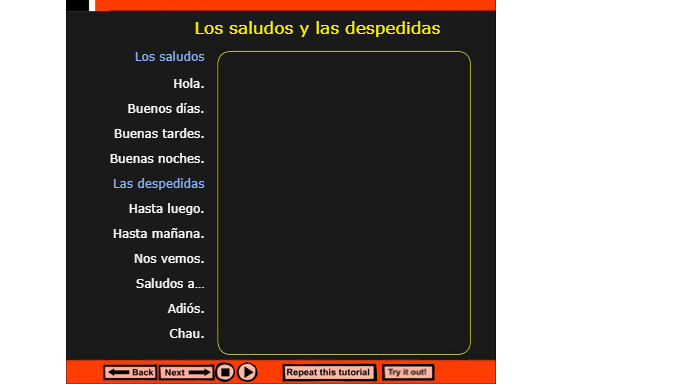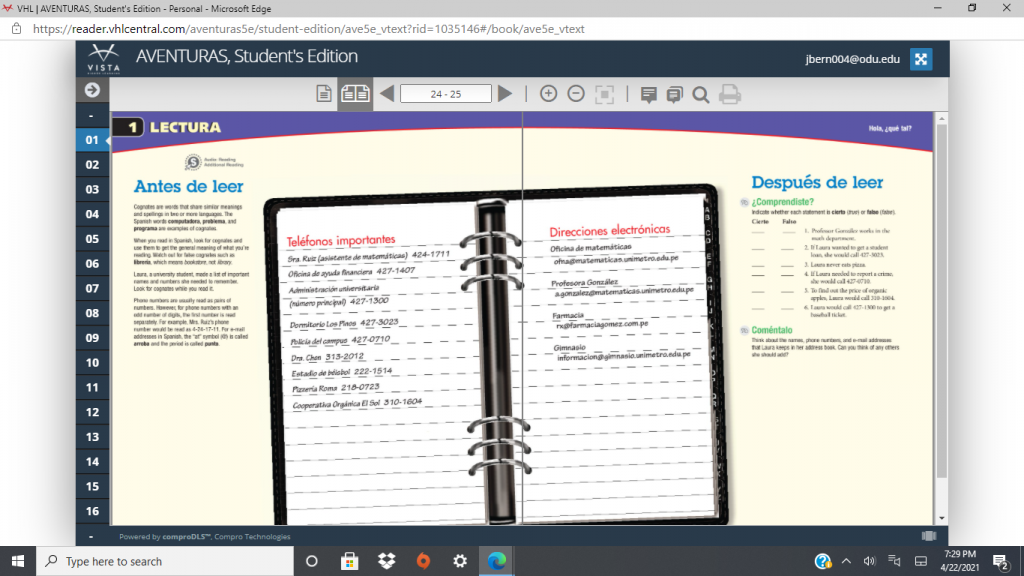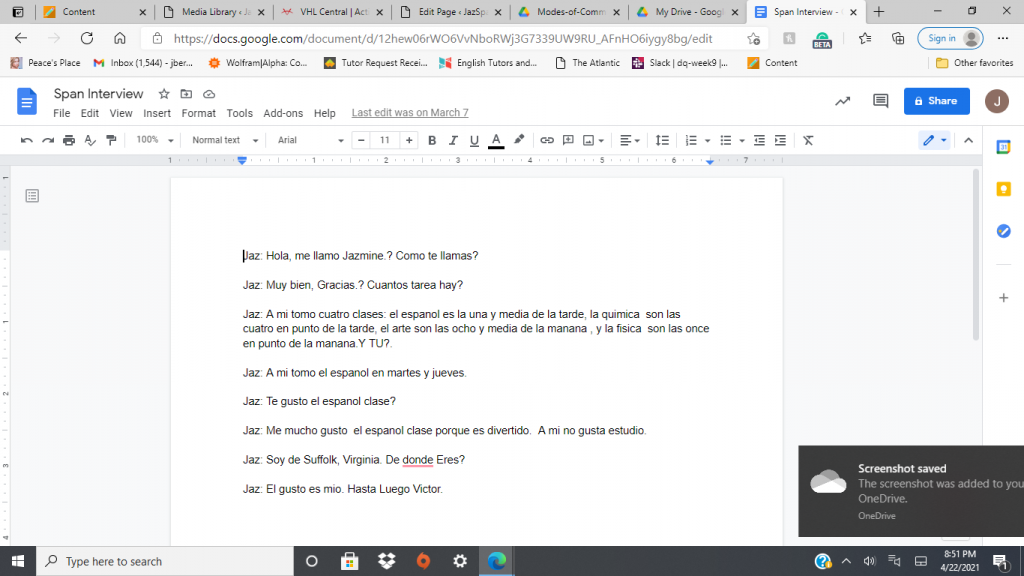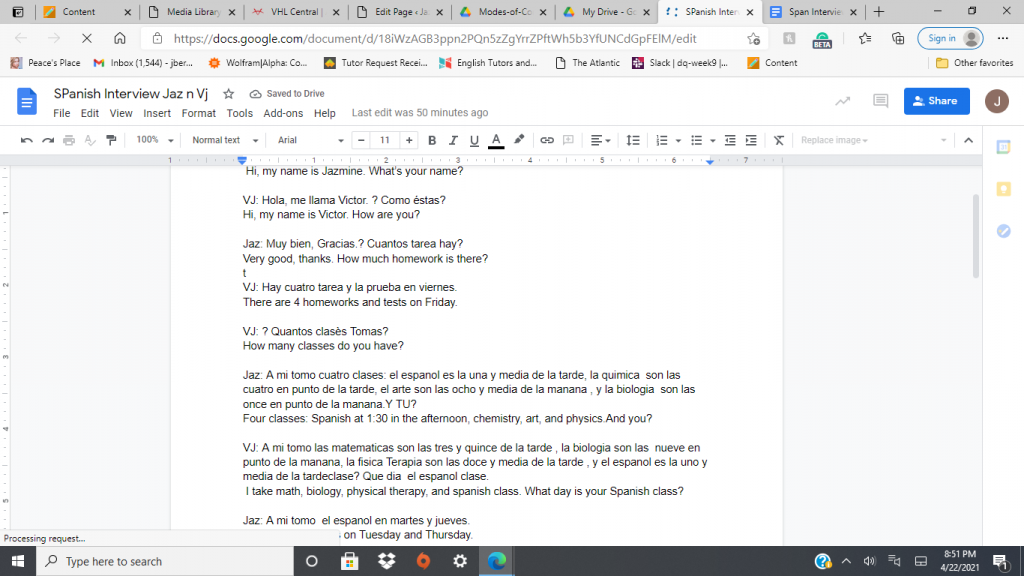Interpretive, Interpersonal, and Presentational Modes of Communication
Address the reflection exercises in each of the following sections. For each section, you will need to embed portions of these assignments and activities as artifacts to substantiate your reflection. Then, at the end of each section, include a link to the document or embed it as a PDF.
Tutorials are available:
- Embedding a PDF
- Embedding Media (Images, Audio)
- Embedding a Video
Exploring Culture
In this course, Vhl has been a very helpful tool in understanding Spanish and the culture that Spanish speakers have. There are various activities and videos that give extra information about the vocabulary and how the vocabulary relates to people’s lives.
Things that aren’t common or acceptable where I live specifically are very acceptable where other people live. It’s a huge cultural switch and some of the things that I’ve learned are very different but also somewhat similar to things that I experienced. For example, the values that Spanish speakers have for their families are very similar to different cultures. Also, the immense passion that Spanish speakers have for sports such as soccer, is very similar to the passion that Americans have for sports such as football or baseball. The one misconception I had was that learning Spanish would be very difficult because the language was so foreign to me, but I’ve learned that with practice it isn’t hard to understand, but a new experience. Aside from that, I didn’t have too many misconceptions about Spanish people, even though the media can have an awful way of portraying people. If anything, I’ve gained a more honest understanding of the kind of people that they are and the things that they partake in their day-to-day lives.
¡Fútbol en España! (vhlcentral.com)
Encuentros en la plaza (vhlcentral.com)
Engaging in Communities
Before taking this class, I didn’t see the importance of learning a new language or learning about Spanish culture. Now that I’ve picked on the language, mannerisms, and cultural traditions and practices, I’m more knowledgeable and interested in learning Spanish and the people who speak it. It’s important to engage in immediate and global communities because the world is extremely diverse and there are people who speak all types of languages. Communication becomes more fluid and the ability to understand and speak a language eliminates language barriers. I’m able to be more careful and knowledgeable about how to act around people who are used to different cultural norms. For example: In Spanish-speaking countries, the people are very social and personal space isn’t as common as it is in places like America. Since I’m aware of this, I know that if I’m approached by someone who is used to those practices, I’ll know not to be offended or uncomfortable. I’ve included a video below from an assignment that highlights their sociability and common meeting places.
Encuentros en la plaza (vhlcentral.com)
Interpersonal Communication
In this video, my partner and I completed a presentation where we held a conversation in Spanish for an assignment. The conversation was based on two students talking after class. We covered topics like greetings, our names, classes, and time.
I was confident about my partner and the conversation we created for the presentation. One thing we struggled with is remembering our lines long enough to finish the conversation, but with practice and familiarizing ourselves with the vocabulary we eventually did a good job. I’d say we did pretty well with pronunciation, but next time I would practice a bit more so the conversation would have gone smoother, and not so stiff.
Presentational Speaking
On vhl we had some talking assignments that required us to listen to different pronunciations of letters and words and then repeat them back to the best of our ability for a grade. This is similar to the other videos that vhl had that said vocabulary words to us, but these activities ensured that we were actually reading and speaking the vocabulary and that our teacher could hear how we pronounced the words.
These assignments weren’t too complicated. I appreciated that they made me say the words out loud. In some activities I found myself absorbing the material visually, but I wasn’t understanding how to say chunks of the material out loud. There were also similar portions in the homework where they said words out loud and asked for us to repeat them and I skipped over the speaking because it wasn’t required. I most likely should have been more mindful, but luckily I didnt have too much difficulty pronouncing words.
Presentational Writing
Throughout the semester we had a few different writing prompts based off of the topic we were currently on. Some of them included writing our family tree in spanish, and describing our family. Unfortunately I misplaced my documents but I did practice writing out sentences for a group assignment before I shared with my partner and other written assignments.
The biggest challenge in finishing some of those assignments was coming up with enough interesting things to say that translated correctly in Spanish. I knew some things from my notes, and from the vocabulary, but in the more tedious assignments(describing our family for example), my sentences began to get repetitive. Fortunately, the activities didn’t require us to outdo what we are capable of and I had to remind myself constantly that it was normal to be frustrated when learning and writing another language. Another issue I faced was remembering what my sentences in Spanish meant in English because I am very forgetful. A good tactic I used to eliminate some difficulty from that was to type the correct translation in English below it so I was seeing what everything meant and I didn’t have to rely on my poor memory. I definitely think that I excelled in description words, but struggled with verbs. If I had another chance to do it all from the beginning, I definitely would have spent more time studying and going over verbs because they become muddled with each other since many of them sound and look similar.
Interpretive Listening

In this photo is a video from vhl. On vhl we get different words at the beginning of each chapter, and these videos goes through them and pronounces them out in Spanish.
These videos are really helpful for a few reasons. One of the biggest reasons is that it allows you to hear and read the word before the assignment, which also allows you to practice it. It allows you to rewind it so it also gives you time to write it down. These videos are important because some people might be able to understand and write Spanish, but still pronounce words incorrectly. It helped me practice some of the more difficult words. Sometimes It does get bothersome to have to dig through the assignments on Vhl to find the pronunciation videos, but it’s a very helpful feature.
Interpretive Reading
Unfortunately, because of covid my lack of immediate resources, I haven’t been able to be too involved with Spanish culture outside of class, but in our textbook, there are many activities that allow everyone to engage. We have activities where we have to read a phonebook and answer questions based on the provided information or analyze a virtual pamphlet for events and answer questions about those.
I found these activities to be very fulfilling because they included a good portion of the vocabulary from the chapter and allows us to see the vocabulary used in full sentences. The one obstacle I ran into was trying to piece together sentences that I didn’t fully understand yet. Thankfully, knowing the vocabulary, using context clues, and answering the assignment questions made it easier to properly understand the information. I was also able to pick out words that weren’t in the vocabulary so that I could use them in different assignments to make more interesting sentences.


